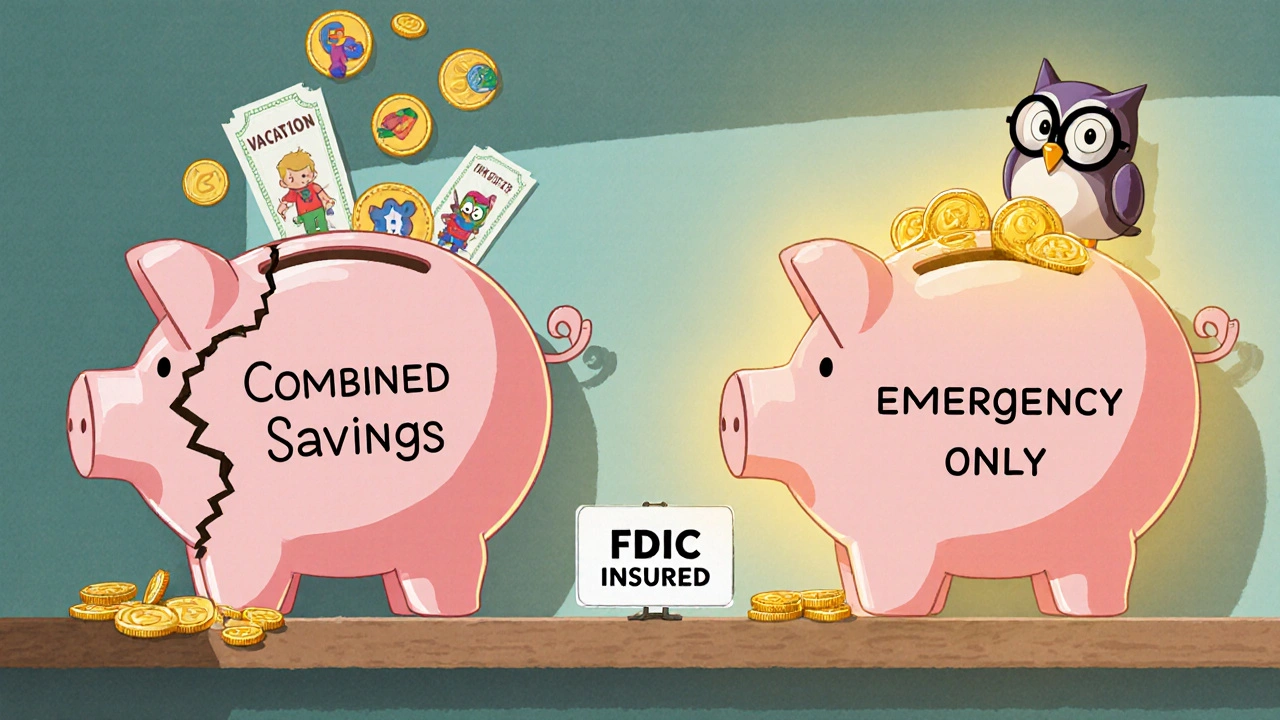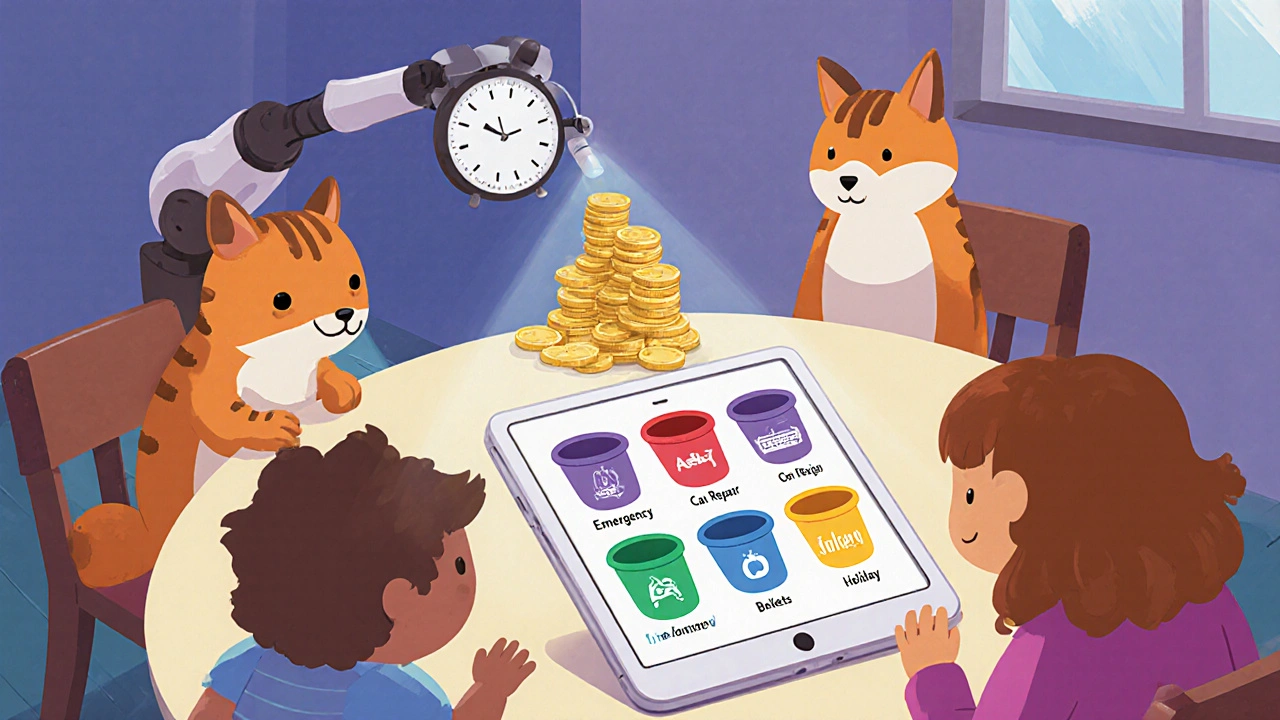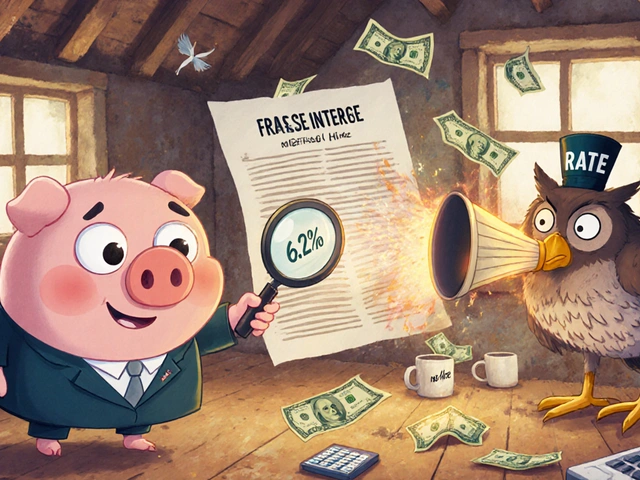Emergency Fund Calculator
Your Emergency Fund Needs
Fund Strategy Comparison
Separate Accounts
Your target:
Combined Accounts
Your target:
68% of people with combined funds use it for non-emergencies
Your Strategy Recommendation
Why Your Emergency Fund Needs a Clear Home
Most people know they need an emergency fund. But how many actually have one that works? The problem isn’t saving money-it’s keeping it where it belongs. A 2022 Federal Reserve report found that 37% of Americans couldn’t cover a $400 emergency without borrowing. That’s not bad luck. That’s poor organization. If your emergency fund lives in the same account as your vacation savings or your new TV fund, it’s not really an emergency fund. It’s just money you’ll spend when things get tough.
What’s the Difference Between an Emergency Fund and Regular Savings?
An emergency fund isn’t just another savings account. It’s your financial fire extinguisher. It’s for things you can’t plan for: a broken water heater at 2 a.m., a sudden job loss, or a surprise medical bill. Regular savings? Those are for things you do plan for-like a vacation, a new car, or holiday gifts. Mixing them is like keeping your first-aid kit in the same drawer as your socks. You’ll never find it when you need it.
Financial experts have been clear on this since at least 2007, when Suze Orman pushed the 3-6 month rule: keep enough saved to cover your essential living costs for that long. That’s not a suggestion. It’s a safety net. And if you’re pulling from it to pay for a weekend getaway, you’ve already lost.
Separate Accounts: The Gold Standard
Eighty-two percent of certified financial planners recommend keeping your emergency fund in its own account. Why? Because psychology matters more than spreadsheets.
When your emergency money is in a separate high-yield savings account-like Ally Bank, Marcus by Goldman Sachs, or Discover-you create mental boundaries. You don’t see it when you check your balance. You don’t think, “I’ve got $10,000 here, I can afford a new laptop.” That’s the power of separation. A 2023 study in the Journal of Consumer Research found that 68% of people who kept their emergency fund mixed with other savings ended up dipping into it for non-emergencies.
Real people confirm this. On Reddit’s r/personalfinance, one user wrote: “I kept them combined for years and kept raiding it for vacations-separated them last year and now have $8,000 in emergencies versus $200 previously.” That’s not magic. That’s clarity.
These accounts typically pay 4.00-5.25% APY as of late 2024, so your money grows while it waits. Plus, they’re FDIC-insured up to $250,000 per bank. No risk. No fees. Just fast access when you need it.

Combined Accounts: A Risky Shortcut
Some people swear by combining everything. The FIRE (Financial Independence, Retire Early) crowd, especially users on forums like Mr. Money Mustache, argue that naming your dollars in a spreadsheet works just as well. One user, ‘BudgetWizard,’ says he’s kept $28,000 in one account since 2016, with $18,000 labeled for emergencies-and never touched it for anything else.
It’s possible. But it’s rare.
EBNEMO’s 2023 study of 5,000 account holders found that people using combined funds were 27% more likely to drain their emergency reserve during a crisis. Why? Because the brain doesn’t like labels. When you’re stressed, tired, or tempted, your brain goes for the easiest option: the money you can see.
And if you’re new to saving? Don’t even try it. The National Foundation for Credit Counseling found that 73% of beginners fail to protect their emergency fund when it’s mixed in. If you’re still learning how to budget, don’t add mental gymnastics to the mix.
Hybrid Options: Sub-Accounts and Smart Tools
What if you hate having too many accounts? There’s a middle ground: sub-accounts.
Banks like Capital One and SoFi now let you create labeled “buckets” inside one savings account. You can name one “Emergency,” another “Car Repair,” and another “Holiday.” It’s not perfect, but it’s better than no separation at all. These tools use behavioral nudges-like hiding the emergency bucket from your main balance view-to reduce temptation.
Some banks even go further. Capital One’s “Emergency Savings Boost” automatically moves money from your checking account when your balance hits a certain level. SoFi is testing AI that detects income drops and temporarily increases your emergency allocation. These aren’t sci-fi-they’re real features available now.
How Much Should You Save? And How Fast?
Start small. The Consumer Financial Protection Bureau recommends a four-phase plan:
- Phase 1: $500 in 30 days. This covers small emergencies-flat tires, lost phone, minor medical bills.
- Phase 2: One month’s expenses in 6 months. Use automatic transfers. Set it and forget it.
- Phase 3: Three months’ expenses. This is the baseline for most households.
- Phase 4: Six months’ expenses. Only if you’re the sole income earner, self-employed, or work in a volatile industry.
Automation is your best friend. A 2024 Ally Bank study found that people who set up automatic transfers saved 2.3 times more than those who moved money manually. If you have to think about it, you’ll skip it.

Who Should Use Separate Accounts? Who Can Get Away With Combined?
It’s not one-size-fits-all. Here’s who wins with each approach:
- Use separate accounts if: You’re new to saving, struggle with impulse spending, have a single income, or feel anxious about money. This is the default recommendation for 9 out of 10 financial planners.
- Try combined accounts if: You’ve been budgeting for years, track every dollar, use apps like YNAB or Monarch, and have no history of raiding your savings. Even then, you need discipline, not just a spreadsheet.
There’s a clear income pattern, too. Federal Reserve data shows 58% of households earning over $100,000 have separate emergency funds. Only 22% of those earning under $40,000 do. That’s not because the wealthy are smarter-it’s because they have more room to manage complexity. If you’re living paycheck to paycheck, simplicity wins.
What About Inflation? Isn’t Cash Losing Value?
Yes. Cash loses 2-3% of its buying power every year during high inflation. That’s real. But here’s the catch: your emergency fund isn’t for investing. It’s for survival.
If you put it in stocks or bonds to chase returns, you risk losing access right when you need it most. That’s not smart-it’s dangerous.
Instead, focus on the right kind of cash: high-yield savings accounts with FDIC insurance. They’re not perfect, but they’re the safest, most liquid option. Some experts, like Fidelity, now suggest a “tiered” approach: keep one month in cash, two months in money market funds, and three months in short-term bonds. But that’s only for people who already have a solid emergency fund and understand market swings. Don’t start here.
What’s the Bottom Line?
If you’re reading this because you’re unsure where to put your emergency savings, the answer is simple: separate account.
It’s not glamorous. It’s not flashy. But it works. It stops you from spending your safety net. It gives you peace of mind. And it’s backed by data from the Federal Reserve, the CFPB, and thousands of real people who learned the hard way.
Open a high-yield savings account today. Name it “Emergency.” Set up a $50 or $100 auto-transfer. Forget about it. In six months, you’ll have $300-$600 saved. In a year, you’ll have a real cushion. And when the car breaks down or the job disappears, you won’t panic-you’ll just pay the bill.
That’s what an emergency fund is supposed to do.




I kept my emergency fund in the same account as my 'maybe buy a new phone' money for 2 years. Ended up using it for a flight to visit my dad when he got sick. Didn't even think about it until I was standing at the airport counter. Now I have a separate account with Ally. $50/month auto-transfer. It's not glamorous, but I sleep better. 😌
The psychological boundary is everything. I used to think labeling accounts was overkill-until I got laid off and had to dip into savings. I panicked because I couldn’t tell what was ‘real’ emergency money. Now I use Capital One’s sub-accounts. Emergency bucket is hidden from my main dashboard. No temptation. No guilt. Just quiet security. This isn’t about being rich-it’s about being smart with limited mental bandwidth.
Y’all are overcomplicating this. FIRE folks aren’t wrong-they’re just operating on a different level. If you’re tracking every penny in YNAB and you’ve got 18 months of expenses in a single account with zero impulse draws, congrats. You’re the 3%. But for the rest of us? Separate accounts. Full stop. High-yield savings = free money while you wait. And if you’re still using a regular checking account? You’re basically leaving cash on the table while gambling with your safety net. Stop being a hero. Just open the damn account. 🚀
This isn’t even a debate. The data is unequivocal. 68% of people who mix funds raid them. 73% of beginners fail. The Federal Reserve says 37% can’t cover $400. That’s not a personal failure-it’s a systemic design flaw. People aren’t weak. The system is rigged to exploit cognitive overload. Sub-accounts are a Band-Aid. Real solution? Banks should auto-segregate emergency funds by default. No opt-in. No labels. Just a locked, high-yield, FDIC-insured vault you can’t touch unless it’s a true emergency. Until then? Separate accounts. No exceptions. No excuses.